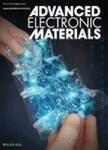版权所有:内蒙古大学图书馆 技术提供:维普资讯• 智图
内蒙古自治区呼和浩特市赛罕区大学西街235号 邮编: 010021

作者机构:Yonsei Univ Sch Mech Engn 50 Yonsei Ro Seoul 03722 South Korea Yeungnam Univ Sch Mech Engn 280 Daehak Ro Gyongsan 38541 Gyeongbuk South Korea
出 版 物:《ADVANCED ELECTRONIC MATERIALS》 (Adv. Electron. Mater.)
年 卷 期:2019年第5卷第2期
核心收录:
基 金:National Research Foundation of Korea (NRF) - Korea government (MSIT) [NRF-2018R1A2A1A05023070] Ministry of Education [NRF-2016R1D1A1B03932028]
主 题:carbon nanomaterials contact resistance flexibility transparency ultraviolet monitoring
摘 要:Transparent and flexible UV sensors have attracted considerable attention for use in portable/wearable optoelectronic systems. Although UV sensors based on photoactive nanomaterials have been reported for such applications, achieving full transparency and flexibility remains a challenge because they still rely on opaque or brittle electrodes. Here, a fully transparent, flexible, and highly sensitive UV sensor based on 1D carbon nanotubes (CNTs)-2D graphene hybrid is demonstrated. Under UV illumination, oxygen molecules on the CNT surfaces are desorbed by photoinduced plasmon energy, leading to a significant decrease in hole concentration, and correspondingly an increase in the electrical resistance of CNT. The combination of CNT and graphene minimizes the effect of contact resistance and facilitates effective charge transfer between them without potential barrier, resulting in a high photoresponse, which is 30 times as high as that of Au-electrode-based CNT sensor. Simultaneously, CNT-graphene UV sensor shows remarkable transparency (over 80% at 550 nm) and outstanding mechanical flexibility without any significant change in electrical resistance for 500 cycles at a bending radius of 5.5 mm. The integration of CNT-graphene hybrid onto flexible substrates through scalable microfabrication is expected to provide exciting opportunities for the development of high performance, optically and mechanically invisible optoelectronic devices.